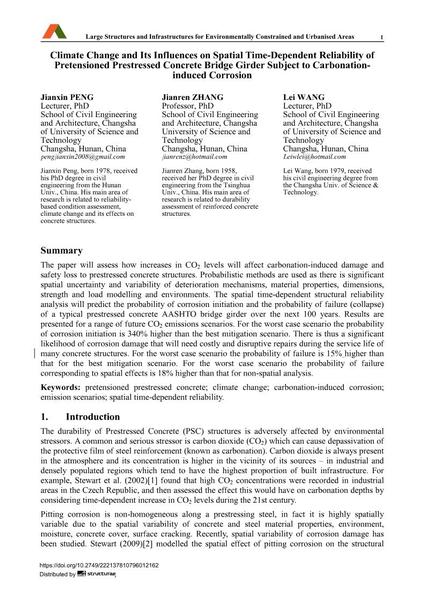Climate Change and Its Influences on Spatial Time-Dependent Reliability of Pretensioned Prestressed Concrete Bridge Girder Subject to Carbonation- induced Corrosion

|
|
|||||||||||
Bibliographic Details
| Author(s): |
Jianxin Peng
Jianren Zhang Lei Wang |
||||
|---|---|---|---|---|---|
| Medium: | conference paper | ||||
| Language(s): | English | ||||
| Conference: | IABSE Symposium: Large Structures and Infrastructures for Environmentally Constrained and Urbanised Areas, Venice, Italy, 22-24 September 2010 | ||||
| Published in: | IABSE Symposium Venice 2010 | ||||
|
|||||
| Page(s): | 136-137 | ||||
| Total no. of pages: | 8 | ||||
| Year: | 2010 | ||||
| DOI: | 10.2749/222137810796012162 | ||||
| Abstract: |
The paper will assess how increases in CO₂ levels will affect carbonation-induced damage and safety loss to prestressed concrete structures. Probabilistic methods are used as there is significant spatial uncertainty and variability of deterioration mechanisms, material properties, dimensions, strength and load modelling and environments. The spatial time-dependent structural reliability analysis will predict the probability of corrosion initiation and the probability of failure (collapse) of a typical prestressed concrete AASHTO bridge girder over the next 100 years. Results are presented for a range of future CO₂ emissions scenarios. For the worst case scenario the probability of corrosion initiation is 340% higher than the best mitigation scenario. There is thus a significant likelihood of corrosion damage that will need costly and disruptive repairs during the service life of many concrete structures. For the worst case scenario the probability of failure is 15% higher than that for the best mitigation scenario. For the worst case scenario the probability of failure corresponding to spatial effects is 18% higher than that for non-spatial analysis. |
||||
| Keywords: |
climate change emission scenarios pretensioned prestressed concrete carbonation-induced corrosion spatial time-dependent reliability
|
||||
